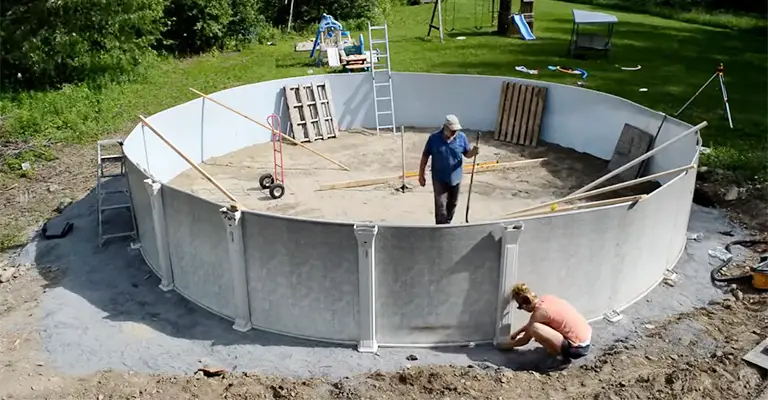If you’re looking to create a sturdy and level foundation for your pool, a concrete slab can be an excellent choice. This simple process will help ensure the pool remains stable and safe for all your swimming adventures.
Above-ground pools can be installed on concrete as long as the surface is level. The majority of concrete patio slabs in backyards are poured at an angle so rainwater can run off. How thick should a concrete slab be for an above ground pool?
Above-ground pools require only a two-inch thick concrete pad. Due to the way water distributes its weight, there is no need for a real structure to hold the pool in place.
If you feel better about pouring a thicker slab, you are welcome to do so. The only thing it will do is cost you more money.
The level of the slab matters more than the concrete’s thickness. As you will not be able to adjust the bottom track of the pool, you will want it perfectly level.
For example, If you want to build a 15′ round pool, make a 17′ slab. A nice barrier will surround the pool, and there will be plenty of room for the frame to sit on (1 foot around).
Don’t forget that when placing a pool on concrete, you’ll need foam coving and a ground pad.
You Can Follow These Steps To Build An Above Ground Pool Slab
Building a concrete slab for an above-ground pool requires careful planning and execution to create a stable and level surface. Here is a guide to help you build a concrete slab for an above ground pool step by step.
1. Check Local Regulations
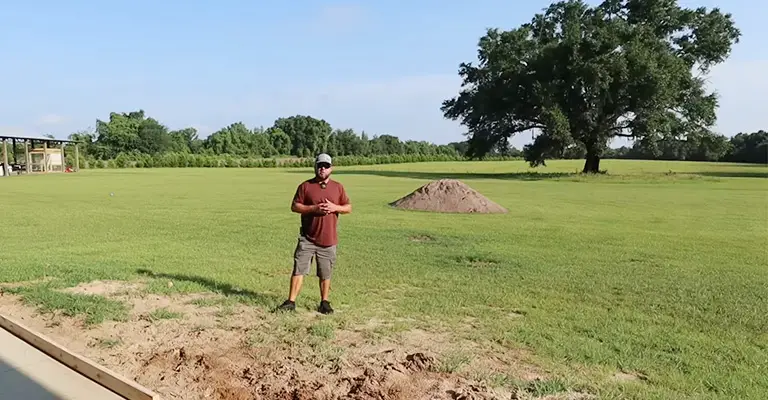
Before starting any construction, check with your local authorities or building codes to ensure you comply with any regulations or permits required for pool installation.
2. Choose a Suitable Location
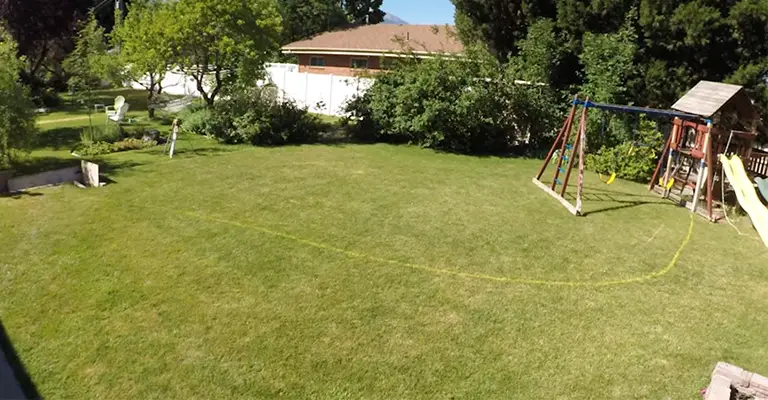
Select a level area in your backyard where you want to place the above-ground pool. Ensure the ground is free from any rocks, debris, or roots that could disrupt the concrete slab’s integrity.
3. Measure and Mark the Area
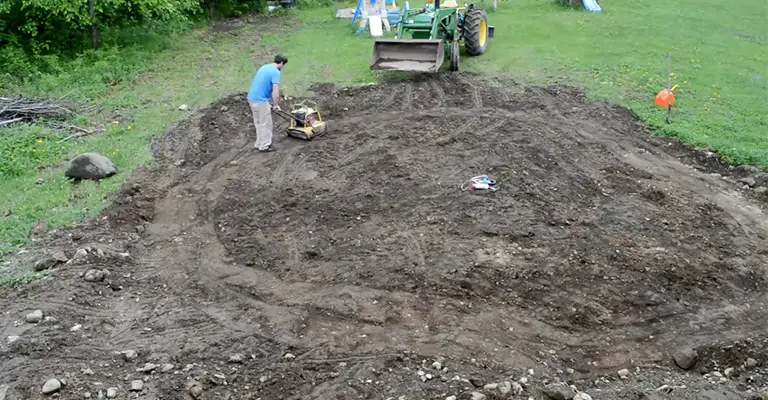
Measure the dimensions of your pool and mark the area on the ground, allowing for extra space around the pool’s perimeter for decking or walking space.
4. Excavation
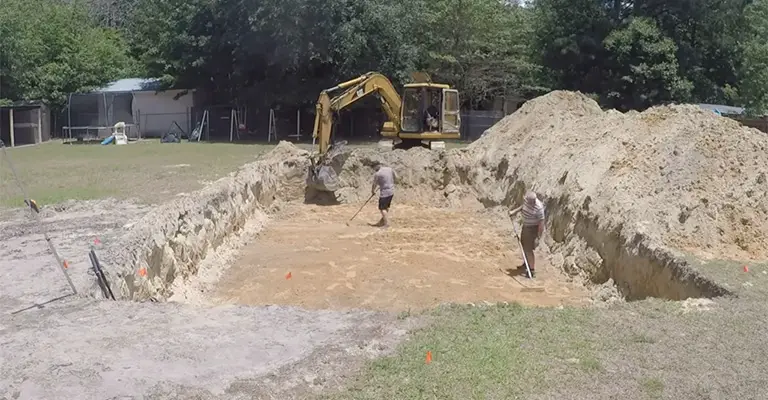
Use a shovel or a small excavator to dig out the marked area to a depth of about 4-6 inches. Make sure the excavation is level and even.
5. Create a Base
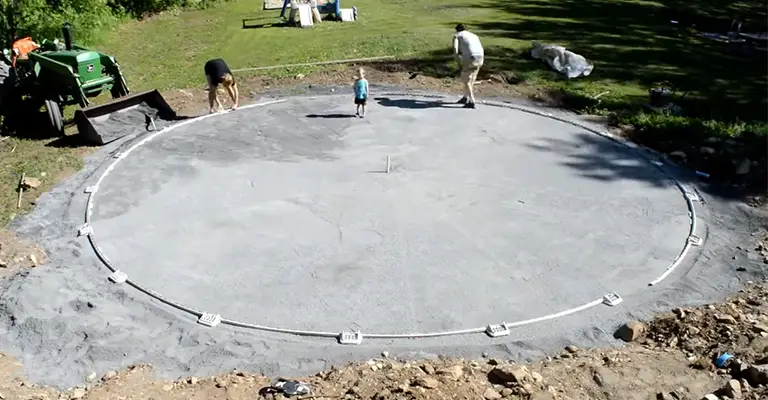
Fill the excavated area with a layer of gravel or crushed stone. This base will provide drainage and prevent the concrete from settling unevenly.
6. Build Forms
Construct sturdy forms around the excavated area using wooden boards or metal stakes. The forms will contain the concrete and help you shape the slab. Ensure the forms are level and square with the pool’s outline.
7. Install Reinforcement
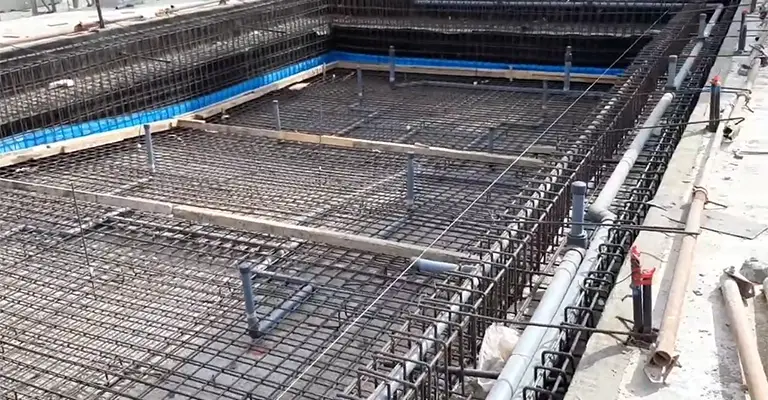
Place a steel mesh or rebar grid within the forms to reinforce the concrete and add strength to the slab.
8. Mix and Pour Concrete
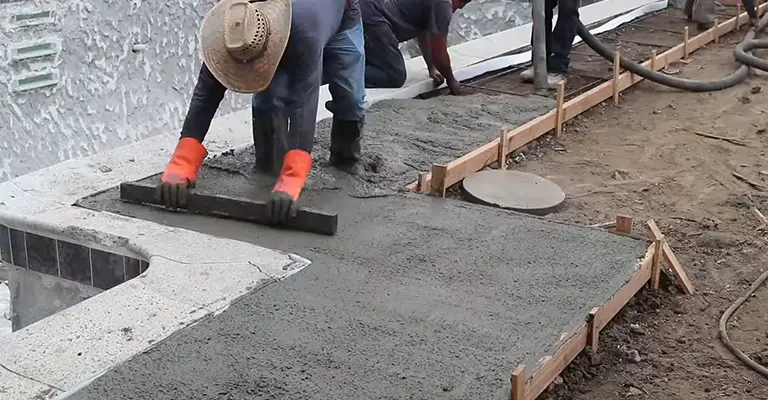
Prepare the concrete mix according to the manufacturer’s instructions or hire a concrete contractor to pour the concrete for you. Pour the concrete evenly into the forms, ensuring it reaches the desired thickness.
9. Level and Smooth
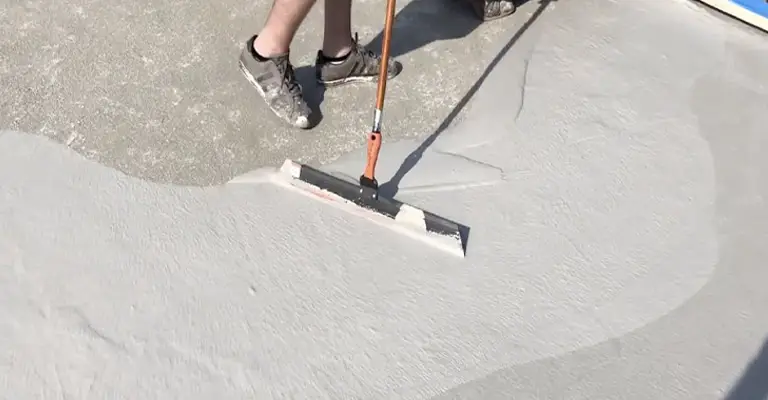
Use a screed or a straight board to level the surface of the concrete, smoothing out any bumps or uneven areas.
10. Cure the Concrete
Allow the concrete to cure for several days. During this time, keep the slab moist by spraying water on it regularly to prevent cracking.
11. Remove Forms
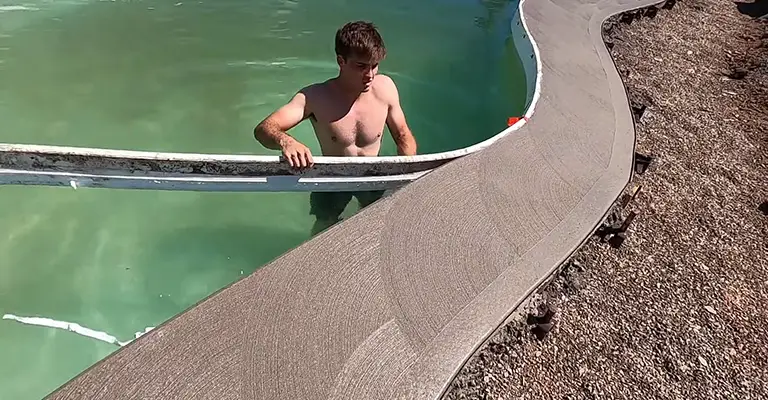
Once the concrete has fully cured, carefully remove the forms from around the slab.
12. Install the Pool
With the concrete slab in place, you can now proceed to assemble and install the above-ground pool according to the manufacturer’s instructions.
13. Add Decking or Finish
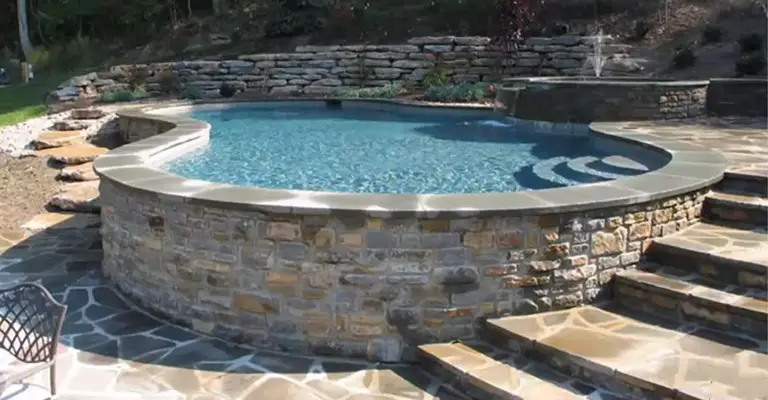
If desired, you can add decking or finish the surrounding area to create a more attractive and functional pool space.
Remember, building a concrete slab for an above-ground pool may require some specialized tools and expertise.
If you’re unsure about any step in the process, it’s always a good idea to seek advice from a professional or hire a qualified contractor to ensure a successful and safe pool installation.
Is It Okay To Put an Above-Ground Swimming Pool on a Concrete Slab?
An above-ground pool is a great alternative to a built-in pool if space or budget are constraints. It’s best to place one of these pools on a concrete pad rather than directly on the ground. The pad should be flat and level when it is constructed properly.
Furthermore, concrete pads keep the pool’s base above ground, preventing deterioration from moisture and mold. There are a few requirements for concrete pads, but they are common sense criteria.
A Pad Protects the Pool from Rain and Snowmelt
Swimming pools need protection from water, especially around their bases, even though it might seem paradoxical.
The weight of the water in the pool creates a protected environment under the pool when it is set directly in the ground, allowing runoff and snowmelt to naturally seep underneath.
Mold can also degrade the vinyl liner, creating unsanitary conditions for kids. A pad will allow rainwater and snowmelt to drain off the concrete rather than going under the pool.
Furthermore, water flowing naturally in the yard will bypass the pool and flow around the pad. In this way, soil erosion under the pool cannot cause it to be out of level.
A Concrete Pad Is Strong
The thickness of concrete slabs ranges from 4 to 8 inches. Concrete slabs as thin as 4 inches can support weights as high as 1,700 kilograms per square centimeter, or 24,123 pounds per square inch.
You can easily support a round pool 18 feet by 4 feet deep on this foundation. There are about 30,000 gallons of water in such a pool, and the water weighs around 125 tons, exerting a pressure equal to four pounds per square inch on the slab. Cracks or deformations of the slab are unlikely to occur in the pool.
The Pad Must Be Flat and Level
Leveling the ground where you intend to install an above-ground pool is essential. A difference of more than 1 inch is evident on one side of the pool compared to the other, according to one installer.
It can cause the pool to lose significant amounts of water. If the difference is more than three inches, it will probably cause damage to the pool quickly.
The process of leveling bare ground is much more difficult than leveling a concrete pad. Since concrete is a liquid, it will level itself on an uneven surface.
Fresh concrete, by virtue of its liquid nature, naturally flattens, preventing protrusions, like tree roots, from puncturing the liner.
Tips For Pouring A Concrete Slab For An Above Ground Pool
It is fairly straightforward to pour a concrete pool pad above ground. For a better product, here are a couple of tips.
1. Insulate A Concrete Floor Before Pouring
To mold and pour concrete slabs and to provide insulation under concrete floors, the same tools and skills are needed.
Make sure that 12 inches of dirt are excavated beneath the slab’s intended top level. Filler and insulation can be placed under the slab in this way.
Gravel is used to fill the excavation. Under the slab, any wiring or plumbing pipes go through a layer of rock.
Make sure the gravel is level across the entire floor. Cover the floor with plastic. Plastic acts as a vapor barrier, preventing moisture from rising through gravel and onto concrete floors.
Inside the shape, the borders should be insulated. Make sure the forms are constructed in each dimension to account for this. A rake should be used to level off the sand on the insulation. Sand should be reinforced with reinforcing rods or wire.
Pour concrete over the sand. You should level the concrete with shovels and rakes before using a screed to run across the top edge of the forms. The concrete should be smoothed out with a trowel.
2. Foam Coving Is Required As Well As A Liner Guard/Pad
Coving is required for every above-ground pool with a metal wall. In most cases, earth or sand will be used as the coving. Sand sifts out from under a concrete wall when a pool is on concrete, so sand coves are not recommended.
Display pools on concrete in showrooms were originally designed with foam coving. In concrete pools, it’s necessary because it won’t move or break down.
Additionally, I have found that liners will leak if they rest directly on concrete. The concrete bottom must be separated from the liner by something.
It is easiest to use a liner guard for this situation as it is easy to install, and it is designed specifically for it. Concrete pool bottoms can be padded with other things.
While Styrofoam sheeting works well, it is costly and more difficult to install since the sheets must be cut and duck taped tight together.
Additionally, carpet is commonly used as a barrier for the bottom. I have also found this to be effective.
3. It’s Okay For Concrete Slabs To Crack
I have seen people place a bunch of expansion joints in strange positions to prevent a slab from cracking in the future.
Because they think the pool’s water will cause the concrete to crack, they are overly concerned about this issue.
One thing I know for sure as a pool guy for more than three decades is that concrete decks usually crack. Do what you can to prevent it, but don’t be upset if it happens.
It is possible that the concrete cracks so badly that you can feel it in the pool’s bottom. It’s not as bad as it sounds, as the only inconvenience is feeling it. The pool won’t be damaged by a crack.
4. Pour Concrete In The Bottom Of The Pool Before Erecting The Wall
Although it might make sense to pour concrete only in the bottom of the pool (and not on the outside), this would be restrictive.
The concrete forms with the pool’s bottom track and wall when it’s poured after the wall has been erected.
The concrete floor will never be able to support a replacement if there is ever an issue with the pool.
The old pool will have to be removed and a new one installed by cutting a strip of concrete along the perimeter.
An above ground pool won’t last a hundred years, but concrete will. More than once in the last 34 years, I have had to remove concrete and replace it. Pouring concrete after the wall goes up is something I would avoid if possible.
5. Make Sure The Slab Is Level
You shouldn’t be concerned about this if you’re having a concrete contractor pour the concrete. It is important that you level the wall of the pool at least half an inch if you are doing it yourself.
In the finished pool, even an inch difference between the slabs will be noticeable. This is the level you want to reach.
6. Maintain Thickness
Concrete patio slabs are usually 4 inches thick. A 2″ thick pour will suffice for an above-ground pool.
The cost of concrete is high. If you make a 2″ thick pour, you can save some money. As pool water is heavy, some people will believe that the concrete needs to be at least 4 inches thick.
The water weight is evenly distributed, so this is not necessary. This is an option I’m bringing up to save some money.
You may find that some structural engineers disagree with this statement. It’s the internet, where everyone anonymously has access to more information than anyone else.
Since I’ve seen a 2″ pour work well in real life several times, I know it will work well. According to me, this is more important than what some pasty geek says based on his indoor-only math.
7. Make The Slab Bigger
The slab should be at least one foot larger than the pool. Make sure the slab matches the pool’s size rather than trying to make it perfect.
There’s nothing Swiss about above-ground pools. It is common for them to not be precisely shaped and to not be manufactured with exact dimensions.
For example, if you plan to build an above-ground pool that measures 24 feet round, you should ideally pour a slab 26 feet round.
This will give you an extra ledge all the way around the pool. In addition, if the pool is egg-shaped, you will have plenty of space.
Most Existing Concrete Slabs Are Off Level, But Not All
Assuming your slab is level is also not a good idea. Some of them are perfectly level. The backyard of a homeowner had a basketball court, so I built a pool there last year. The ground was perfectly level.
Laying down a four-foot level won’t give you an accurate reading of whether your slab is level. Levels of any length will tell you if something is incorrect, but many people don’t understand how to read them.
You should either use a line level or a builder’s level that you can borrow or rent.
There is little point in renting a laser level or builder’s level for two minutes if you don’t have access to one. The best bet would be to use a two-dollar line level and some string.
A nylon string should be tightly stretched across the slab and a few inches above it by placing stakes in the ground beyond the slab.
The line-level should be attached to the string once it has run across the concrete. This line-level attaches easily to the string because it’s designed to do so.
By raising or lowering the string at one or both ends, adjust the level using a line level. The string should be perfectly level by the time the line level shows it.
As soon as you have determined that the string running across the slab is perfectly level, you can measure down to the concrete on both ends. Off-level slabs have different numbers, indicating how far they are from level.
Bottom Line
With above-ground pools, you can enjoy the cool summer waters without enduring lengthy construction periods, high costs, or time-consuming maintenance.
In the absence of guidelines or standards, above-ground pools are not required just because they are simpler and more affordable.
Maintaining your above-ground pool will extend its lifespan if you follow a few general guidelines. Concrete shouldn’t be the only support for above-ground pools.
Flat concrete slabs protect against moisture accumulation and mold growth by acting as a protective framework.

